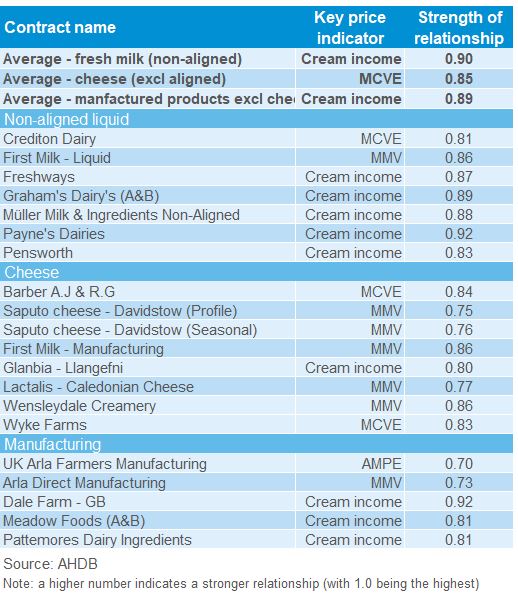How to get a head’s up on milk price changes
Tuesday, 20 July 2021
By Patty Clayton
The direction farmgate prices are likely to take over the next few months can, in part, be assessed using the AHDB Milk Market Value (MMV) indicator. The MMV measures the value of milk on GB markets, and provides a forward view on the direction and size of future milk prices.
However, this indicator is based on average market returns, as measured by AMPE and MCVE, and not all milk prices are impacted by the same market movements. Individual processors set and adjust the price of milk differently depending on their exposure to market volatility, the length of contracting periods with the customers, the structure of their supply chains and competition in the market.
On average, we’ve found that around 60% of the change in the value of milk (MMV) on the GB market flows through to farmgate prices[1] in about 3-4 months’ time. For some processors, it will be the value of bulk cream which will trigger price changes, while for others it could be cheese returns.
So how can you assess the likelihood that your milk price will change?
We’ve identified the leading indicator of milk price changes across milk pricing schedules, by looking at the relationships between movements in various market indicators and individual contract prices over the three-year period 2018-2020.
These are listed in the table below, grouped into three categories based on the primary use of the milk. In each case the indicator has been lagged by 3 months, as it typically takes this long for changes in market values to flow through into farmgate price movements.
As expected, MCVE is the closest indicator for milk prices from cheese manufactures, while cream income appears to be the main indicator for most non-aligned liquid milk prices.
The table also shows how strong the relationship between the milk price and key market indicator. was in the period 2018-2020. The higher the number, the stronger the relationship, with 1.0 being the highest.
If your milk buyer isn’t listed, then use the averages at the top based on which market your buyer operates in.
Knowing how the relevant sector of the market is performing, and what the outlook is, can help you assess the likelihood that your milk price will change, and whether you need to revisit your budgets and profit projections. It won’t give you an exact view, but it will give you a ‘heads up’ on the likely direction of travel.
In addition to keeping up to date with our regular market analysis, you can get an overview of how we expect dairy markets to develop in the future from our semi-annual Agri-market Outlook, due for release later this month.
[1] Analysis excludes prices paid for milk in retailer aligned pools, as these prices are determined by costs of production.
Sign up to receive the latest information from AHDB.
While AHDB seeks to ensure that the information contained on this webpage is accurate at the time of publication, no warranty is given in respect of the information and data provided. You are responsible for how you use the information. To the maximum extent permitted by law, AHDB accepts no liability for loss, damage or injury howsoever caused or suffered (including that caused by negligence) directly or indirectly in relation to the information or data provided in this publication.
All intellectual property rights in the information and data on this webpage belong to or are licensed by AHDB. You are authorised to use such information for your internal business purposes only and you must not provide this information to any other third parties, including further publication of the information, or for commercial gain in any way whatsoever without the prior written permission of AHDB for each third party disclosure, publication or commercial arrangement. For more information, please see our Terms of Use and Privacy Notice or contact the Director of Corporate Affairs at info@ahdb.org.uk © Agriculture and Horticulture Development Board. All rights reserved.


